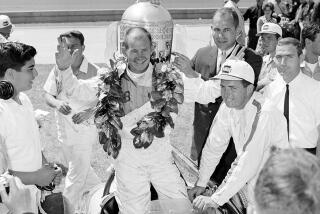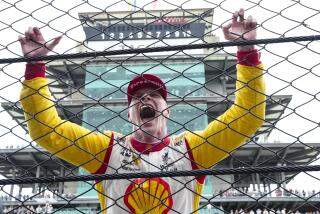Smooth Shift : Nigel Mansell Couldn’t Be Happier With Switch From Formula One to Indy Circuit
- Share via
Nigel Mansell can’t believe the way he walks around smiling all the time. It isn’t that he is the fastest Indy car driver on the premises. It’s that--sore back and all--he’s having the time of his life in his new American environment.
The 39-year-old Englishman was often the fastest Formula One driver, too, but that didn’t mean he was smiling. Much of the time--even while winning his first world championship last year--he was feuding with his car owner, his chief rivals and most of the Formula One hierarchy.
“In this series, everyone works together,” Mansell said Saturday after running a record lap of 108.198 m.p.h to win the pole for today’s Toyota Grand Prix of Long Beach. “The bonding between all the constructors, officials, drivers, it’s excellent.
“In Phoenix, I was playing golf with Bobby Rahal, having a wonderful time together on the links. That could never happen in Formula One, having fun with your competition. Never.”
For the record, Mansell defeated Rahal, the PPG Cup Indy car champion, one up, in a 12-hole match on the Wigwam course. Mansell is a two-handicap golfer who has played in the Australian Open.
It was partly because he wanted to be able to golf year-round, often with his close friend Greg Norman, that Mansell moved his family to Clearwater, Fla., from the Isle of Man, a tiny island in the Irish Sea.
“I think even the culture here is refreshing. It’s something my children are adapting to very quickly at school. The greatest vote of confidence I’ve got is that my wife (Rosanne) said to me that more people have been accommodating here already than there were in the last 12 years in Europe.”
The results of his first race did nothing to change his feelings.
On a street course similar to the one in Long Beach, Mansell won at Surfers Paradise, Australia. It was close--he ran out of fuel a few yards past the finish line--but his domination was not lost on his rivals.
It was the first time a driver had won his first Indy car race since another Englishman, Graham Hill, won the Indianapolis 500 in 1966.
At Phoenix, in his first time on an oval, he got his comeuppance during practice when he smacked the concrete wall with such force that it blasted a three-foot hole through the wall and knocked blocks of concrete 100 feet. His speed was estimated at 182 m.p.h. upon impact.
“I thought I was dreaming,” he said. “I said to myself, ‘This isn’t happening,’ then I felt the pain and I knew it was happening.”
Team engineers blamed the spin-out on a change in chassis setup and a set of old tires.
“With the changes we made in the car (during practice), he probably would have been fine if he had been on new tires,” team manager Jim McGee said.
Mansell wanted to race the next day but was denied permission by Dr. Steve Olvey, Indy car director of medical affairs, because of a mild concussion. There was a crease in the rear of his helmet where he had apparently been struck by the left-rear wheel, which was knocked off at impact.
Mansell flew home the morning of the Phoenix race, in time to watch teammate Mario Andretti break a five-year drought and win another race for the Newman-Haas team. Mansell spent most of the two weeks recuperating before coming to Long Beach on Thursday, in time to sign autographs at a Kmart open house.
Still hurting from the bruises of his Phoenix crash, Mansell had the cockpit in his Lola-Ford fitted with cushions before going out to qualify Friday.
The result was no different from having a fit Mansell at the wheel. He broke the track record with a lap of 107.659 Friday, then came back Saturday to raise it to 108.198. The speeds bettered that of the man he replaced, Michael Andretti, who did 106.251 last year.
For the past two weeks, Mansell has been undergoing treatment in and out of a hospital in Florida.
“I thought I was able to race the next day, but when I got home, I went downhill for four or five days. It was the worst feeling I have ever had from racing. I’m still feeling the effects of the hit.”
He had to be helped from his car after practice Friday and was taken to the team motor home, where ice packs were applied to his back before qualifying.
And how does he expect to last 105 laps today?
“When the race starts, you ignore the pain,” he said. “You just go about your job, and when it’s over, you can start worrying about the pain again on Monday. The most important thing is for me to manage my energy (before the race), so that I will have a reservoir for two hours Sunday.”
Mansell drove three times at Long Beach in a Formula One car, but he says the track has changed so much that he finds little about it that is the same.
“The track is much easier now,” he said. “When I was here 12 or so years ago, we went up the hill to the main highway (Ocean Boulevard) and then dipped back down again. For my back’s sake I’m glad we’re not doing that, but I would like to see a few more corners. The track is pretty straightforward the way it is now, although what corners there are can be challenging.”
As far as the difference in cars is concerned, Mansell said there was no way they could be compared.
“One is one, and the other is another,” he said. “I know that I had to relearn my trade, and I’m sure other Formula One drivers like Emmo (Emerson Fittipaldi) had to do the same when they came to Indy cars. A race car driver can drive any type of car, but he definitely has to go through a relearning process when he switches.”
The Indy car is 500 pounds heavier, has steel brakes instead of carbon fiber, has a gear shift instead of a computerized gearbox and has a turbocharged engine instead of a normally aspirated one.
“The car is heavier, and is definitely a different breed, but it is a thoroughbred,” he said. “What also has helped me in my comfort zone is working with the mechanics and engineers, and certainly working for Carl (Haas) and Paul (Newman). And having Mario as my teammate has been extremely helpful. I’m sure he is the best teammate I’ve ever had in my career, based on his wealth of experience, and his friendly and cooperative attitude.”
Mansell won a record nine races and 14 pole positions last year in Formula One, but after acrimonious wrangling most of the season with car owner Frank Williams, he accepted an offer from Haas and Newman to replace Michael Andretti on the Kmart-Havoline team this year.
The move had a tremendous impact on the world racing community, as no standing champion had ever given up his position in Formula One to race elsewhere. In the short time he has been here, Mansell said he learned to prefer the Indy car approach to racing.
“In Formula One in recent years, so much revolved around technology,” he said. “The driver was being taken out of the equation. (In Indy cars), I feel more like a driver again.
“And I know when I have questions about the car, I can get the answers from Jim McGee, who is second to none in terms of experience, and Peter Gibbons (chief engineer). I’ve never made a transition to a team as easy as I have to the Newman-Haas team from the engineering sense. And I’m delighted to have inherited Michael Andretti’s mechanics. I believe I get on well with all the crew and that’s a compliment to them.”
The closeness of today’s starting grid also impressed Mansell.
“Look at how tight it is. There were 13 cars within one second of one another (in qualifying). That means about that many are capable of winning the race. In Formula One, there aren’t usually more than two or three that are truly competitive.
“You can see the difference in the racing. Both the race in Australia, and the one in Phoenix, were very competitive. I don’t think you can say that about the three Formula One races this year.”
Indicative of the closeness of Indy car racing is that in two races, six drivers have been on the podium--Mansell, Fittipaldi and Robby Gordon in Australia, and Andretti, Raul Boesel and Jimmy Vasser at Phoenix.
Grand Prix Lineup No. Driver: Qualifying Speed 1. Nigel Mansell: 108.198 2. Paul Tracy: 107.705 3. Emerson Fittipaldi: 107.548 4. Scott Goodyear: 107.529 5. Stefan Johansson: 107.247 6. Mario Andretti: 107.238 7. Teo Fabi: 106.875 8. Al Unser Jr.: 106.505 9. Raul Boesel: 106.493 10. Eddie Cheever: 106.464 11. Bobby Rahal: 106.453 12. Danny Sullivan: 106.151 13. Robby Gordon: 106.027 14. Mark Smith: 105.989 15. Scott Pruett: 105.845 16. Scott Brayton: 105.474 17. Adrian Fernandez: 105.318 18. Roberto Guerrero: 105.040 19. Arie Luyendyk: 104.981 20. Hiro Matsushita: 104.971 21. Jimmy Vasser: 104.902 22. Dave Kudrave: 104.094 23. Robbie Buhl: 103.402 24. Buddy Lazier: 103.069 25. Marco Greco: 102.629 26. Ross Bentley: 102.541 27. Lyn St. James: 99.345 28. Jeff Wood: 99.032
More to Read
Go beyond the scoreboard
Get the latest on L.A.'s teams in the daily Sports Report newsletter.
You may occasionally receive promotional content from the Los Angeles Times.










